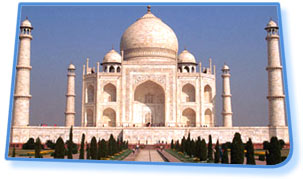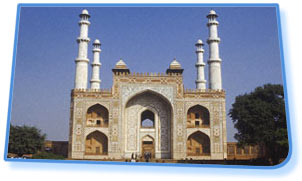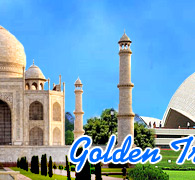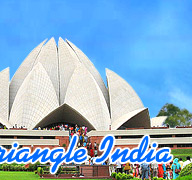 The source of the name 'Taj Mahal' is not very clear but scholars believe
that it originated from the abbreviation of the empress' name, Mumtaz
Mahal and translated to 'Crown Palace'. As the small details integrate
together, one is awed by the costliness and large quantities and finery
of the materials used, which ranges from marble to precious gemstones.
The first illustration that might come to one's mind at a remark about
Taj Mahal is that of a central domed building but the true appreciation
comes only when one sees it as the manifestation of one man's
unfathomable and unshakable desire for the woman he loved - the woman
who proved her loyalty and everlasting friendship to him till her last
breath, a woman of great physical and inner beauty and a woman of
substance and strength.
The source of the name 'Taj Mahal' is not very clear but scholars believe
that it originated from the abbreviation of the empress' name, Mumtaz
Mahal and translated to 'Crown Palace'. As the small details integrate
together, one is awed by the costliness and large quantities and finery
of the materials used, which ranges from marble to precious gemstones.
The first illustration that might come to one's mind at a remark about
Taj Mahal is that of a central domed building but the true appreciation
comes only when one sees it as the manifestation of one man's
unfathomable and unshakable desire for the woman he loved - the woman
who proved her loyalty and everlasting friendship to him till her last
breath, a woman of great physical and inner beauty and a woman of
substance and strength.It took twenty-two years, thirty-two million rupees and hard toil of more than twenty thousand workers to construct Taj Mahal. Completed in 1648, the documents regarding construction of Taj cite the name of Ustad Isa, a very famous architect, well versed in the Islamic architecture, as its chief architect. The documents also list the names of persons employed for this grand work and and the inventory of the construction materials and from where they were brought. From this source, we have learnt that expert craftsmen from Delhi, Kannauj, Lahore, and Multan contributed to the task along with the specialized tasks being handled by the renowned Muslim craftsmen that came here from Baghdad, Shiraz and Bukhara.
Itmad-ud-daulah
Sometimes known as 'Baby Taj', this mausoleum is considered as the imminent precursor of the Taj Mahal as far as elaborate carvings and inlay work are concerned. Itmad-ud daulah, stands across the River Yamuna from the Taj Mahal. Belonging to the age of Jahangir, it contains cenotaphs of Mirza Ghiyas and Asmat Begum, parents of the powerful Mughal Empress Nurjahan, queen of Jahangir. Jahangir made him his prime minister with the title Itmad-ud-daulah (Pillar of the State). The tomb was built in the famed Char Bagh style that Itmad-ud-Daulah had himself laid out six years before his death 1622. The monument is beautifully conceived in the white marble with mosaic and lattice.
The tomb is not a very large structure as Taj Mahal with a height of only 21 m and a dome-roofed octagonal minaret of 12 m each at each corner. It is the inlay work or pietra dura on the walls of mausoleum that makes it extremely attractive. Marble screens of geometric latticework permit soft lighting of the inner chamber. On the engraved walls of the chamber is the recurring theme of a wine flask with snakes as handles.
Sikandra
 10
km from the city centre of Agra, the construction of the mausoleum of
Akbar was started by Akbar himself. It is a perfect amalgamation of
Hindu, Christian, Islamic, Buddhist, Jain architectural styles. His son
Jehangir completed it and also did many modifications in the original
plan of the building. Named after Sikander Lodhi, the tomb has
three-storey-minarets on its four corners. These minarets are built in
red sandstone with stunning inlay work of marble.
10
km from the city centre of Agra, the construction of the mausoleum of
Akbar was started by Akbar himself. It is a perfect amalgamation of
Hindu, Christian, Islamic, Buddhist, Jain architectural styles. His son
Jehangir completed it and also did many modifications in the original
plan of the building. Named after Sikander Lodhi, the tomb has
three-storey-minarets on its four corners. These minarets are built in
red sandstone with stunning inlay work of marble. There are a number of 'langurs' wandering about in the place as it is surrounded by a beautiful garden. In its premises lies the Baradi palace in the gardens built by Sikander Lodhi. A broad paved causeway leading to the tomb has five storeys and is in the shape of a truncated pyramid. The main tomb has a unique square design which is unparalleled by all other Mughal buildings.
Fatehpur Sikri
40 km from Agra, the city of Fatehpur Sikri served as the capital of the Mughal Empire between 1570 and 1586. But as abruptly as it had been built, it was abandoned due to the scarcity of water. A popular legend is attached to the city's conception. According to it, Emperor Akbar was without a male heir, and was granted one by the blessings of the Sufi saint Sheikh Salim Chisti. In honor of the saint, Akbar named the prince Salim, and decided to found a new city to celebrate his birth. And thus, the magnificent Fatehpur Sikri, the new capital, came into being. The city was intended to embody the noble ideals, and the humanitarian bent of this dynamic emperor. The finest monuments within this area are the Diwan - i - Am, Diwan - i - Khas, Panch Mahal, Jama Masjid, Panch Mahal, Buland Darwaza and the tomb of Saint Sheikh Salim Chisti.
Agra Hotels : Mughal Sheraton - Jaypee Palace - Hotel Taj View - Trident Hilton












